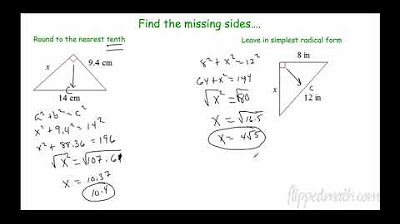Colligative Properties Explained
Summary
TLDRIn this lesson, Mr. Millington explains colligative properties, which are solution characteristics like boiling point, freezing point, vapor pressure, and osmotic pressure that depend on the number of dissolved solute particles. Through various examples, he illustrates how dissolving substances like salt and sugar affect these properties. The more particles a solute dissociates into, the greater the change in boiling and freezing points. Mr. Millington also demonstrates how to calculate these changes using formulas, emphasizing the role of dissociation and the vant Hoff factor in determining a solution's colligative properties.
Takeaways
- 😀 Colligative properties are properties of a solution that depend on the number of dissolved solute particles, not the type of particles.
- 😀 Key colligative properties include boiling point elevation, freezing point depression, vapor pressure lowering, and osmotic pressure.
- 😀 When a solute is dissolved in a solvent, the boiling point of the solution increases and the freezing point decreases.
- 😀 The more dissolved particles present in a solution, the greater the effect on the boiling point and freezing point.
- 😀 Non-ionic compounds, like sugar, dissolve but do not dissociate, meaning they contribute fewer dissolved particles compared to ionic compounds.
- 😀 Ionic compounds, like salt (NaCl) and potassium sulfide (K2S), dissociate into multiple ions, contributing more dissolved particles and causing greater changes in colligative properties.
- 😀 The van't Hoff factor (i) is the number of particles a solute dissociates into. For example, NaCl dissociates into 2 ions (Na⁺, Cl⁻), and K2S dissociates into 3 ions.
- 😀 Boiling point elevation and freezing point depression are calculated using formulas involving the molality of the solution and the van't Hoff factor.
- 😀 A sugar solution with 1 mole of sugar dissolved will have 1 mole of dissolved particles, while 1 mole of NaCl will produce 2 moles of dissolved particles upon dissociation.
- 😀 The greater the number of dissolved particles (as in ionic compounds), the greater the effect on boiling point and freezing point, with NaCl and K2S solutions showing larger changes than sugar solutions.
Q & A
What are colligative properties?
-Colligative properties are properties of a solution that depend on the number of dissolved solute particles in the solution, rather than the type of chemical species present.
Which are some examples of colligative properties?
-Some examples of colligative properties include boiling point elevation, freezing point depression, vapor pressure lowering, and osmotic pressure.
How do colligative properties affect the boiling point of a solution?
-Colligative properties cause the boiling point of a solution to increase when a solute is dissolved in a solvent. The more dissolved particles, the higher the boiling point.
How does the addition of a solute affect the freezing point of a solution?
-The addition of a solute lowers the freezing point of a solution, a phenomenon known as freezing point depression. The more dissolved particles, the lower the freezing point.
What is the Vant Hoff factor (i), and why is it important?
-The Vant Hoff factor (i) represents the number of particles a solute dissociates into when dissolved in a solvent. It is important because it helps calculate the extent of change in boiling and freezing points for ionic compounds.
How do ionic compounds like NaCl affect the boiling and freezing points compared to polar compounds like sugar?
-Ionic compounds like NaCl dissociate into multiple ions in solution, which increases the number of dissolved particles and leads to a greater change in boiling and freezing points. In contrast, polar compounds like sugar do not dissociate and produce fewer dissolved particles, resulting in smaller changes to these properties.
If 1 mole of NaCl is dissolved in water, how many moles of dissolved particles are produced?
-When 1 mole of NaCl is dissolved in water, it dissociates into 2 moles of dissolved particles (Na⁺ and Cl⁻).
How does the number of dissolved particles affect the magnitude of boiling point elevation or freezing point depression?
-The more dissolved particles in a solution, the greater the effect on the boiling point elevation and freezing point depression. This is because the change in these properties is directly proportional to the number of particles in the solution.
What is the formula used to calculate the change in boiling point for a solution?
-The formula to calculate the change in boiling point is: ΔT_b = i × K_b × m, where ΔT_b is the change in boiling point, i is the Vant Hoff factor, K_b is the boiling point constant of the solvent, and m is the molality of the solution.
How do you calculate the freezing point of a solution using the freezing point depression formula?
-To calculate the freezing point depression, use the formula: ΔT_f = i × K_f × m, where ΔT_f is the change in freezing point, i is the Vant Hoff factor, K_f is the freezing point constant of the solvent, and m is the molality of the solution. The final freezing point is then found by subtracting ΔT_f from the normal freezing point of the solvent.
Outlines

Cette section est réservée aux utilisateurs payants. Améliorez votre compte pour accéder à cette section.
Améliorer maintenantMindmap

Cette section est réservée aux utilisateurs payants. Améliorez votre compte pour accéder à cette section.
Améliorer maintenantKeywords

Cette section est réservée aux utilisateurs payants. Améliorez votre compte pour accéder à cette section.
Améliorer maintenantHighlights

Cette section est réservée aux utilisateurs payants. Améliorez votre compte pour accéder à cette section.
Améliorer maintenantTranscripts

Cette section est réservée aux utilisateurs payants. Améliorez votre compte pour accéder à cette section.
Améliorer maintenantVoir Plus de Vidéos Connexes

English Expressions: three-word phrasal verbs

Penggunaan Simple Present Tense dan Contohnya | Kampung Inggris LC

ESL Writing - Summarizing and Paraphrasing

Mastering the Nominative Case in German: A Complete Guide! (Beginner / A1-A2) - 1080p/Full HD 🔥

Geometry – 7.1 Pythagorean Theorem and Its Converse

Symmetrical Name Monsters with Mr. Snyder

Rounding and Working with Significant Figures in Physics
5.0 / 5 (0 votes)
